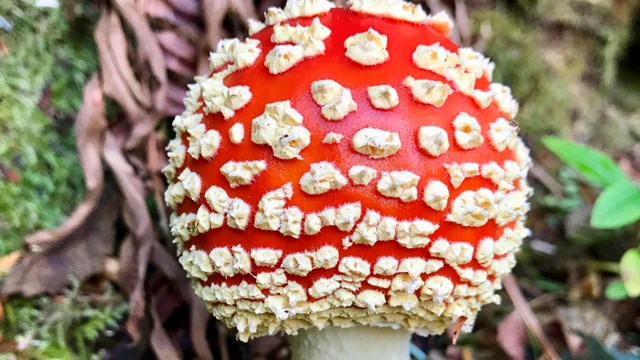
NPS PHOTO More than 250 species of vascular plants and 68 of mosses and liverworts have been documented during recent surveys, and most are represented in the park herbarium. The various park units contain a diversity of habitats that provide niches for a wide variety of plant species. The Sitka spruce vegetation zone forms a narrow band along the Pacific Northwest coast from southeastern Alaska to northern California. The moist, temperate maritime climate and deep, humus-rich soils create ideal growing conditions for conifer trees, resulting in climax spruce-hemlock forests of lush biodiversity and trees of massive size. Sitka spruce (Picea sitchensis) and western hemlock (Tsuga heterophylla) are the park's dominant conifer species. Western red cedar (Thuja plicata), Douglas fir (Pseudotsuga menziesii), red alder (Alnus rubra), cascara (Rhamnus frangula), red elderberry (Sambucus racemosa) and several willows (Salix species) are also common. Salal (Gaultheria shallon), huckleberries (Vaccinium species), and many ferns, mosses, liverworts, and lichens share the forest understory. In November of 1805, explorer William Clark described the coastal forest at Cape Disappointment: "Spruc Pine grow here to an emense Size & hight maney of them 7 & 8 feet through and upwards of 200 feet high ... I observed in maney places pine of 3 or 4 feet through growing on the bodies of large trees which had fallen down, and covered with moss."Most of these giant trees were cut for timber between 1850 and 1950. Today the majority of the park's forestlands are 30-50-year-old mixed conifer stands in various stages of regeneration. To learn about the park’s efforts to restore the forest, see our Natural Features & Ecosystem page. Two rare estuarine plants, flowering quillwort (Lilaea scilloides) and smallflower water pimpernel (Samolus valerandi ssp parviflorus), grow on the tidal mudflats and slough banks of the Lewis and Clark River. The Fort Clatsop unit also contains several acres of willow scrub-shrub wetlands, a habitat type that has largely disappeared from the Columbia estuary over the last century. A resident Roosevelt elk herd frequently browses this willow swamp in winter. At Cape Disappointment, coyote bush (Baccharis pilularis) is at the northern limit of its range and is the only recorded occurrence of this species in Washington state. Two other rare plants recently noted at Cape Disappointment are floating marsh pennywort (Hydrocotyle ranunculoides) and seacliff bluegrass (Poa unilateralis). Collecting plants in the park is prohibited without a National Park Service permit. |
Last updated: September 17, 2020


